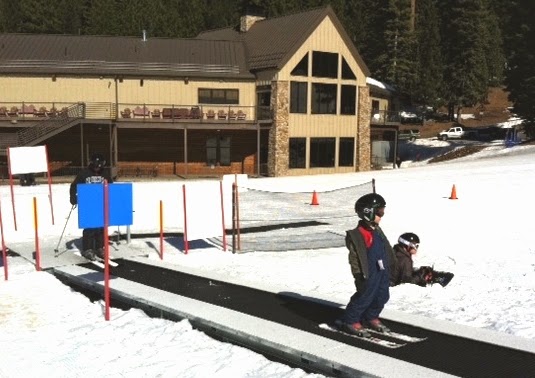With the extended Thanksgiving holiday fast-approaching and family/guests in town, take a day's tour of California's Gold Rush history. Your exploration should include Sutter’s Mill in Coloma's James Marshall Gold Discovery Park, just 80 miles from Stockton, and a scenic tour down Highway 49 through a handful of historic cities on your return home.
John Sutter (also plan a visit to Sutter's Fort in central Sacramento), a Swedish immigrant, received a Mexican land grant in 1839 giving him rights to develop a good portion of the Sacramento and American River Valleys. As his empire expanded, he needed lumber to fuel his construction projects and he partnered with James Marshall to find and build a nearby lumber mill in the Sierra foothills.
Marshall, along with John Sutter's Indian guide, Nerio, found accessibility in the valley of the Cul-Luh-Mah Native Americans, plenty of pine trees and a river (the South Fork of the American) strong enough to power a sizable sawmill. Since the area around Sutter's Mill was beyond his grant, he signed an agreement with the Nisenan Indians.
The first boards destined for Sutter’s empire in Sacramento were milled in March, 1848 and millwork would continue until only 1850. Marshall would discover gold in the tailrace of the mill on January 24, 1848. Due to gold's discovery, the land soon became too valuable, the Gold Rush was on, California’s population would quadruple and land around the mill was sold for gold claims. The mill's dam was removed, the mill fell into disuse and floods in 1862 destroyed what remained.
The Marshal Gold Discovery Park tells the story not only of Sutter's Mill, but of gold mining in the Sierra from 1849 until the latter part of that century. In the park are re-creations of the Arrastre, powered by horses or mules and used by early Spanish settlers to crush rock for gold and small and large crude stamp mills to pulverize rock to release the gold.
Nearby is the huge nozzle of an hydraulic water monitor (cannon), used to wash down the hillsides so the gold could be placer-mined. After streams, rivers and even the San Francisco Bay began to silt-up, hydraulic mining was outlawed by the state in 1884.
The Marshall Gold Discovery State Park is located on Highway 49, 8 miles north of Placerville. From San Joaquin County, go north on Interstate 5, east on US Highway 50 to Placerville, then north on Highway 49 to the park.
From the gold discovery Park, return southbound on Highway 49 come across Highway 50 and tour downtown Placerville, offering 10 blocks of quaint, historic shops and restaurants.
Continue south on Highway 49 to Plymouth, with several blocks of Gold Rush history and eateries, including the regionally-acclaimed Taste restaurant – wonderful food but reservations required. The nearby Shenandoah Valley offers 40+ wineries for sampling of Zinfandel and other regionally noteworthy wines.
Heading further south on Highway 49, take the old Hwy. 49 turn-off to Amador City and Sutter Creek.
Amador City was founded when Jose Maria Amador, pioneer settler and farmer, mined along an unnamed creek in 1848 and 1849 and found gold. After the easily accessible gold was removed, deep rock mines began to multiply. The Keystone Mine, organized in 1853, became the city's most famous and eventually produced $24 million in gold before closing in 1942. Portions of the old mine, including the rusty headframe, can still be seen towering on the hillside above the town's visitor parking lot.
Amador City offers a quaint five-block walking tour of livable history, including the Amador Hotel, the Imperial Hotel, the Amador School House, a host of old homes and the Keystone Mine. A fine place for lunch or dinner in the city is the Imperial Hotel and Restaurant at the end of the historic district. The hotel offers nine refurbished rooms while the restaurant offers regionally-acclaimed food in a classy, historic setting.
Just two miles away is our favorite gold rush town, Sutter Creek. The old city offers a 10 block stretch of old Main Street complete with bed-and-breakfast, tasting rooms, shops and restaurants. The Hotel Sutter on Main Street is a fine place for lunch or dinner; great pizzas can be found at Gold Dust Pizza, just off Main on Eureka Street.
Your tour will cover almost 200 miles and offers plenty of diversions. Plan an early start, pack your walking shoes and binoculars and enjoy a tour of the scenic foothills and the history that put California on the world map in 1849!
Nearby attractions: Indian Grinding Rocks State Park offers additional insight into Native Americans, Murphys and Ironstone Winery offer more history, Black Chasm Caverns affords an opportunity for would-be spelunkers to ply their craft and Columbia State Historic Park further south along Hwy. 49 is a wonderfully preserved Gold Rush town.
For more information: Coloma, parks.ca.gov/?page_id=484, the Marshall Gold Discovery Museum and Visitor Center, 310 Back Street, Coloma, CA 95613, (530) 622-3470; Plymouth, historichwy49.com/amador/plymouth.html; Amador City, amador-city.com/, (209)267-0682; Sutter Creek, suttercreek.org; (209) 267-1344.
Read more from Tim Viall's travel blog, follow him on Facebook or Twitter; or, email him at tviall@msn.com. Happy travels in the west!







































%2C%2Blopix.jpg)
